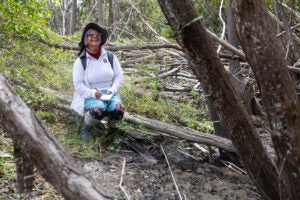This past August, in southern Ecuador amidst dense mangrove forests, scientists were at work. As I followed in her footsteps, Julie Shahan, a Stanford University Ph.D. student, navigated the challenging terrain, burdened by the large 25-pound piece of equipment on her back. This equipment, a gas analyzer, collects measurements to unlock the secrets of soil greenhouse gas emissions. This journey was a collaborative effort between Universidad Espíritu Santo (UEES), Stanford University, Scripps Institute of Oceanography and Environmental Defense Fund.
 With thick mud underfoot and a symphony of scientific measurements being collected around us, Julie deployed the gas analyzer, measuring carbon dioxide and methane emissions from the soil. The data collected during the trip will serve as the bedrock for evaluating the efficacy of the climate mitigation abilities of the impending mangrove restoration projects.
With thick mud underfoot and a symphony of scientific measurements being collected around us, Julie deployed the gas analyzer, measuring carbon dioxide and methane emissions from the soil. The data collected during the trip will serve as the bedrock for evaluating the efficacy of the climate mitigation abilities of the impending mangrove restoration projects.
Mangroves are hailed for a myriad of ecosystem services, but they face danger from the impacts of human activities. Over the past 50 years, mangroves have declined globally. In Ecuador, many mangroves have been converted to aquaculture ponds to grow shrimp. That, coupled with deforestation, poses significant threats to mangroves in this region.
Mangrove restoration is one of many tools in the fight against climate change. Mangrove forests act as carbon sinks, drawing carbon from the air and forming carbon-rich soils among their maze of roots. To better understand this relationship, scientists employ gas analyzers – a laborious and expensive process that limits the scope of measurements. Seeking a solution, the team developed low-cost and lightweight greenhouse gas sensors. Resembling large plastic bowls, these sensors can be placed throughout the mangroves, providing a wealth of data. With the increased measurement frequency and low barriers to entry, local community members are empowered to collect this data, ideally eliminating the need for international researchers to be physically present. These sensors herald a new era of community-led mangrove monitoring, fostering local capacity and reducing emissions associated with travel.
 The local communities around these restoration sites are integral to the next phase of mangrove restoration as well. Professor Natalia Molina from UEES works with local crab fishermen, who dig channels to reintroduce tides into barren ponds on the sites of former mangroves, relying on their historical knowledge of where the channels used to run. This labor-intensive work allows mangrove seeds to root, grow and reclaim the landscape. The research team plans to return to these areas with low-cost sensors to capture the changes since their baseline measurements. Meanwhile, UEES, local fishing communities, and other partners continue restoration, ensuring that these communities can benefit from ecosystem services for years to come.
The local communities around these restoration sites are integral to the next phase of mangrove restoration as well. Professor Natalia Molina from UEES works with local crab fishermen, who dig channels to reintroduce tides into barren ponds on the sites of former mangroves, relying on their historical knowledge of where the channels used to run. This labor-intensive work allows mangrove seeds to root, grow and reclaim the landscape. The research team plans to return to these areas with low-cost sensors to capture the changes since their baseline measurements. Meanwhile, UEES, local fishing communities, and other partners continue restoration, ensuring that these communities can benefit from ecosystem services for years to come.
 This journey into mangrove restoration is a blend of science and community engagement. ”What exists between the mangroves and the community is a perfect symbiosis where the community depends on the mangrove, and the mangrove depends on the community,” tells EDF for Vital Signs Dr. Molina, “Because the community is the only one that can protect the mangrove.”
This journey into mangrove restoration is a blend of science and community engagement. ”What exists between the mangroves and the community is a perfect symbiosis where the community depends on the mangrove, and the mangrove depends on the community,” tells EDF for Vital Signs Dr. Molina, “Because the community is the only one that can protect the mangrove.”










